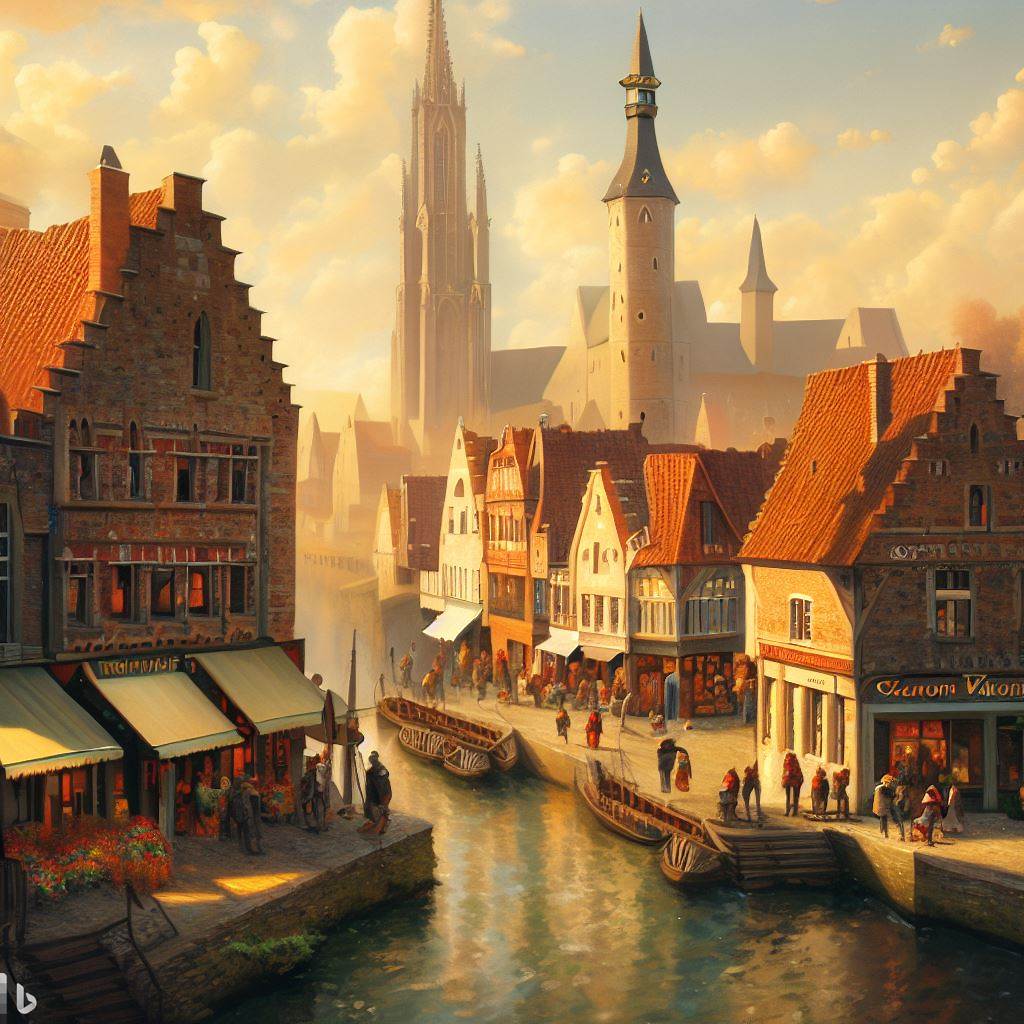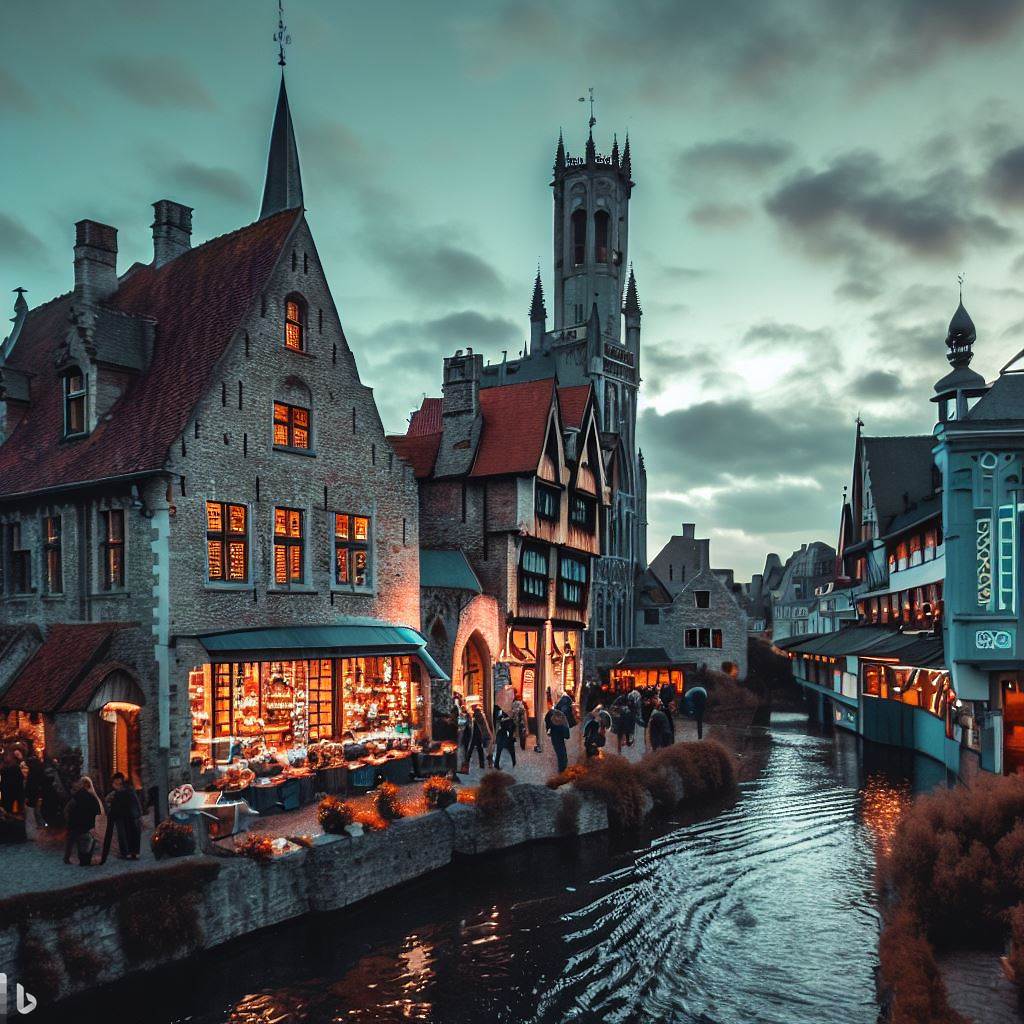Why Were The Towns Of Flanders Busy Trading Centers? Discover the historical significance of Flanders towns as bustling trading hubs. Explore the factors that made these towns thriving centres of commerce and their pivotal role in shaping economic history.
Introduction
Deep within the heart of Flanders, where folklore and history intertwine like intricate tapestries, lies a captivating tale of bustling towns and vibrant trade. Step into a time-worn world of cobblestone streets and ornate guildhalls, where the scent of newly crafted wonders wafts through the air, and the hum of commerce resonates like a mesmerizing melody. In this enchanting land, where every street corner hides a treasure waiting to be discovered, it begs us to ponder: why were the towns of Flanders busy trading centres? Unlock the secrets of this captivating journey as we meander through the annals of time where entrepreneurship and craftsmanship converged, giving rise to an economic force that forever shaped the destiny of these fabled towns. Let us delve into the tapestry of Flanders’ trading past, where the threads of commerce are woven so intricately that the very essence of the region breathes life into every tale spun. Embark with us on this adventure, for within these pages, we shall unravel the enigmatic story of Flanders, a land where trade was not just a means of survival but a celebration of life itself.

1. Unveiling the Vibrant Tapestry of Commerce: Decoding the Bustling Towns of Flanders
Discover the historical significance of Flanders towns as bustling trading hubs. Explore the factors that made these towns thriving centres of commerce and their pivotal role in shaping economic history. Step into the mesmerizing world of Flanders, where history and commerce dance together in perfect harmony. This enchanting region, located in the heart of Belgium, holds within its embrace a vibrant tapestry of bustling towns that have captivated the imaginations of people for centuries. From the grandeur of Antwerp to the hidden treasures of Ghent, each town in Flanders has a unique story to tell, woven with threads of trade, innovation, and cultural richness.
1. Antwerp: Known as the diamond capital of the world, Antwerp sparkles with an energy that is unparalleled. Its historic port, which has been a hub of global trade for centuries, continues to attract visitors from around the globe. Wander through the cobbled streets of the old town, where medieval architectural wonders stand side by side with trendy boutiques and mouthwatering chocolate shops. Discover the breathtaking beauty of the Cathedral of Our Lady, a masterpiece of Gothic architecture, and lose yourself in the exquisite art collection of the Royal Museum of Fine Arts. Antwerp is a city that seamlessly blends past and present, offering a visual feast for all who visit.
2. Ghent: Nestled between the ancient Bruges and the vibrant Brussels, Ghent is a hidden gem waiting to be explored. Step back in time as you stroll along the picturesque canals, admiring the medieval buildings that reflect the city’s rich past. Ghent’s famous Gravensteen Castle is a sight to behold, dominating the skyline with its imposing presence. Lose yourself in the enchanting beauty of Saint Bavo’s Cathedral, home to the world-renowned Ghent Altarpiece, an awe-inspiring masterpiece by the Van Eyck brothers. Ghent’s lively atmosphere and vibrant cultural scene make it a must-visit destination for art enthusiasts and history buffs alike.
As you dive deeper into the fascinating towns of Flanders, you’ll find a treasure trove of stories waiting to be uncovered. From the charming canals of Bruges to the architectural wonders of Brussels, each town reveals a distinct facet of this region’s rich heritage. Indulge in the tantalizing flavours of Flemish cuisine, marvel at the intricate tapestries that adorn historic buildings, and immerse yourself in the warmth and hospitality of the locals. Flanders truly is a place where the past intertwines with the present, painting a vivid portrait of a region that has left an indelible mark on the tapestry of commerce and culture.

2. Tracing the Ancestral Pulse of Exchange: Unraveling Flanders’ Trade Epiphany
Have you ever wondered how trade became such an integral part of our global society? Well, let’s take a journey back in time to Flanders, a region in Europe known for its bustling trade routes and prosperous markets. As we delve into the ancestral pulse of exchange, we will unravel the trade epiphany that transformed Flanders into a trading powerhouse.
- The Dawn of Flanders’ Trade: Picture this – a vibrant marketplace buzzing with merchants from every corner of the world, eagerly displaying their goods. This was the scene in Flanders during the medieval era. With its strategic location along major trade routes, Flanders became a melting pot of cultural exchange and economic prosperity. Merchants from Italy, France, England, and beyond converged here to trade goods such as textiles, spices, and precious metals. The diverse range of products available in Flanders made it a prime destination for traders, attracting wealth and fostering the growth of towns and cities.
- The Rise of Guilds: As trade flourished in Flanders, guilds emerged as essential institutions that regulated and protected the interests of traders. Guilds were associations of craftsmen and merchants who banded together to establish standards, safeguard their professions, and negotiate with authorities. These guilds played a vital role in maintaining quality control, providing training, and resolving disputes, effectively ensuring fair trade practices. They also fostered a sense of community among members, promoting collaborations and knowledge sharing. It’s fascinating to think about how these guilds laid the groundwork for present-day trade associations, fostering a spirit of cooperation and mutual support.
Join us on this riveting exploration of Flanders’ trade history as we unravel the secrets behind its enduring trade epiphany. Discover how the pulse of exchange resonated through the ages and shaped the economic landscape we know today. Gain insights into the fascinating world of medieval traders, their remarkable journeys, and the impact of their endeavours on shaping our interconnected global economy.
3. From Flemish Forge to Flourishing Markets: The Extraordinary Evolution of Flanders’ Trading Towns
Have you ever wondered how towns in Flanders, Belgium transformed from small villages to bustling centres of trade? It’s a story as fascinating as it is remarkable. Let’s dive into the extraordinary evolution of Flanders’ trading towns and uncover the secrets behind their success.
1. **A Forge of Ingenuity**: Flanders’ vibrant trading towns owe their beginnings to the ingenuity of its people. With their skilled craftsmanship, the Flemish transformed their region into a forge of innovation. From intricate tapestries to brilliant stained glass windows, the towns of Ghent, Bruges, and Antwerp became renowned for their artistry and craftsmanship, attracting merchants from all over Europe.
2. **A Tapestry of Trade**: The trading towns of Flanders were not only known for their craftsmanship but also for their thriving markets. These bustling hubs brought together traders from different parts of the world, creating a rich tapestry of cultures and goods. Exotic spices from the East, luxurious textiles from the Mediterranean, and precious metals from Africa were just some of the treasures that could be found in Flanders’ markets. The prosperity brought by these thriving trade routes turned the once-modest towns into flourishing economic powerhouses.
4. Cradle of Commerce: How Flanders Became the Beating Heart of European Trade
Picture this: a bustling marketplace filled with merchants from every corner of Europe, eager to trade their goods and strike deals. This vibrant scene was a common sight in the region of Flanders during the medieval period. But what made Flanders the epicentre of European trade? Let’s dive into the fascinating history behind Flanders’ rise as the cradle of commerce.
1. Geographical Advantage: Flanders enjoyed a prime location that made it a pivotal hub for trade. Situated in northwestern Europe, it provided easy access to both land and sea routes, connecting major trading centres such as Bruges, Ghent, and Antwerp. Ships from all over the continent flocked to Flanders’ ports, bringing exotic goods from distant lands. This geographical advantage paved the way for Flanders to become a centre of economic activity.
2. Burgeoning Industries: Flanders was not just a strategic location, but its people also played a significant role in its economic success. The region was characterized by skilled craftsmen and textile workers, known for their exceptional craftsmanship and innovative techniques. They produced high-quality woollen and linen fabrics that were highly sought after throughout Europe. This booming textile industry, coupled with the expertise of Flemish weavers, quickly put Flanders on the map as a centre for trade in luxurious textiles.
But Flanders’ influence didn’t stop there! It also excelled in the production of goods like ironwork, glass, and pottery, further diversifying its trade offerings. With a reputation for excellence in various industries, Flanders became synonymous with quality, attracting merchants from far and wide.
In summary, Flanders became the beating heart of European trade due to its advantageous geographical location and the expertise of its skilled craftsmen. Its ports served as gateways to a world of commerce, while its skilled artisans produced high-quality goods that captivated buyers across the continent. The legacy of Flanders as a centre of trade and craftsmanship continues to live on, reminding us of its remarkable journey from a humble region to a bustling epicentre of commerce.
FAQs: Why Were The Towns Of Flanders Busy Trading Centers?
Q: What made Flanders towns bustling hubs of trade during the medieval period?
A: Flanders possessed key characteristics that allowed its towns to flourish as thriving commercial centres. Here are a few notable factors:
- Innovative textile industry: Flanders was renowned for its skilled weavers and advanced textile production techniques, particularly in the production of luxurious woollen fabrics such as Flemish cloth.
- Strategic geographical location: Situated at the crossroads of major trade routes linking northern and southern Europe, Flanders served as an important trade intermediary between regions.
- Access to waterways: The towns of Flanders were advantageously located near navigable rivers and connected to important ports, which facilitated the movement of goods.
- Supportive rulers and institutions: Flanders benefited from the patronage of progressive counts and dukes who actively encouraged trade and commerce. Additionally, the establishment of guilds bolstered economic activities and ensured fairness.
- Cultural diversity and assimilation: Flanders attracted skilled artisans, merchants, and bankers from various regions, fostering a multicultural environment that encouraged exchange and specialization.
These factors collectively contributed to the remarkable economic growth and prosperity experienced by the towns of Flanders during medieval times.
Conclusion
The towns of Flanders flourished as busy trading centres due to their favourable geographical location, skilled craftsmanship, vibrant market fairs, supportive guilds, stability, cultural diversity, and well-developed infrastructure. This legacy of trade and commerce in Flanders has left a lasting impact on the region’s history and economy, cementing its place as a significant player in the medieval European trading network.

















